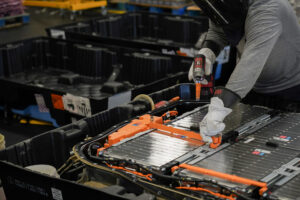
Toyota vehicle fleet now 66% electric in North America, electrified battery recycling expanded
By onMarket Trends
Toyota’s recently released “2023 North American Environmental Sustainability Report” says that 66% of Toyota and Lexus models available to buy in the region now have an electrified option, and more are on the way.
This year’s report found that 93% of all waste Toyota produced in the region was recycled, reused, or repurposed in 2022.
The annual report highlights the OEM’s environmental and sustainability achievements from the full year prior. It also provides information and data on Toyota’s overall environmental strategy and progress on contributions to the United Nations’ Sustainable Development Goals (SDGs) as well as toward the company’s four priority issues — carbon, water, materials, and biodiversity.
“The 2023 report serves as a reflection of our current state, showing that we have made progress in some important and key areas, like carbon and biodiversity, and we expect things to accelerate as we move into the second half of the 2030 agenda,” said Kevin Butt, Toyota Motor North America director of environmental sustainability. “Achieving our goals is no easy task and will require even greater collaboration and commitment from our team members, suppliers, dealers, and other partners and we are committed to taking on the challenge.”
According to the report, Toyota has contributed to five key UN SDGs in line with its four priority issues, including:
-
- Goal 6: Clean Water and Sanitation — 2022 marked the second year of working with The Nature Conservancy to address water shortage issues in the Colorado River Delta;
- Goal 7: Affordable and Clean Energy — Virtual power purchase agreements were made and other methods were employed to increase renewable energy capacity to source at least 45% of the electricity needed for the OEM’s operations from renewable energy by 2026;
- Goal 12: Responsible Production and Consumption — Exploring ways to build a circular ecosystem around electrified vehicle batteries and other materials;
- Goal 13: Climate Action — To achieve carbon neutrality at its facilities by 2035 and across the vehicle life cycle by 2050, Toyota continued to reduce greenhouse gas emissions from its operations by nearly 12% in 2022, offering electrified options for two-thirds of its new vehicle models; and
- Goal 15: Life on Land — Collaboration with Pollinator Partnership and National Environmental Education Foundation to develop more than 10,300 acres of pollinator habitat and support the development of at least 26,000 acres by 2026.
“Toyota remains resolute in its dedication to taking the right steps and implementing a phased approach to achieve the Toyota Environmental Challenge 2050,” the OEM said in a news release. “Through its investments and strategic partnerships, Toyota remains confident that its trajectory will evolve, propelling it closer to its four key focus area aspirations.”
Toyota is also expanding its battery recycling network through a new collaboration with Cirba Solutions, a battery recycling materials and management company.
Toyota had already been working with Cirba Solutions but says the agreement optimizes its logistics network for end-of-life electrified vehicle battery collection, including those from hybrid (HEV), plug-in hybrid (PHEV), and battery electric vehicles (BEV).
“Cirba Solutions’ large and well-established transportation and recycling network ensures Toyota has nationwide battery collection and recycling to reduce both our costs as well as our operational carbon footprint,” said Christopher Yang, Toyota Motor North America business development group vice president. “This moves us closer to our ultimate goal of creating a sustainable, closed-loop ecosystem for our automotive batteries.”
Toyota chose Cirba because of its experience in battery recycling and coast-to-coast collection and recycling network. The companies plan to work together to focus on the collection, transportation, dismantling, and processing of end-of-life lithium-ion electrified vehicle batteries from the Midwest and East Coast regions.
Processing will take place at Cirba Solutions’ Lancaster, Ohio facility, which recently received more than $82 million in grant funding from the U.S. Department of Energy as part of the Bipartisan Infrastructure Law. The facility will use advanced technology to extract critical minerals from scrap and end-of-life batteries with a recovery rate of up to 95% then supply battery-grade metals back into the supply chain, Toyota said.
“Our collaboration with Toyota helps move toward a long-term vision of a sustainable closed-loop battery supply chain,” said Jay Wago, Cirba Solutions chief commercial officer. “With aligned purpose, and Toyota’s growing electric vehicle line-up in North America, we are proud to be a partner.”
Toyota currently collects approximately 25,000 used automotive batteries, primarily nickel-metal hydride batteries found in its HEVs, from its dealership network each year. It expects the number of batteries, particularly end-of-life lithium-ion batteries, to rise as the number of BEVs sold increases. Toyota expects end-of-life batteries will likely double by 2030.
Through the agreement with Cirba Solutions, Toyota expects to reduce its overall transportation and logistics costs by at least 70%.
In North America, Toyota has sold more than 6.2 million combined PHEVs and HEVs since 2000.
Images
Featured image: An end-of-life battery is disassembled by a Cirba Solutions worker. (Provided by Toyota Motor North America)
